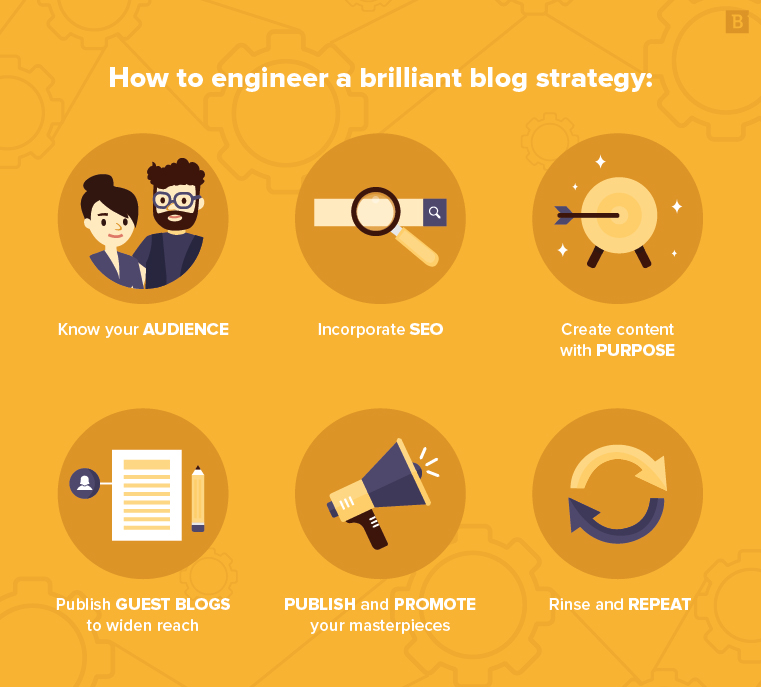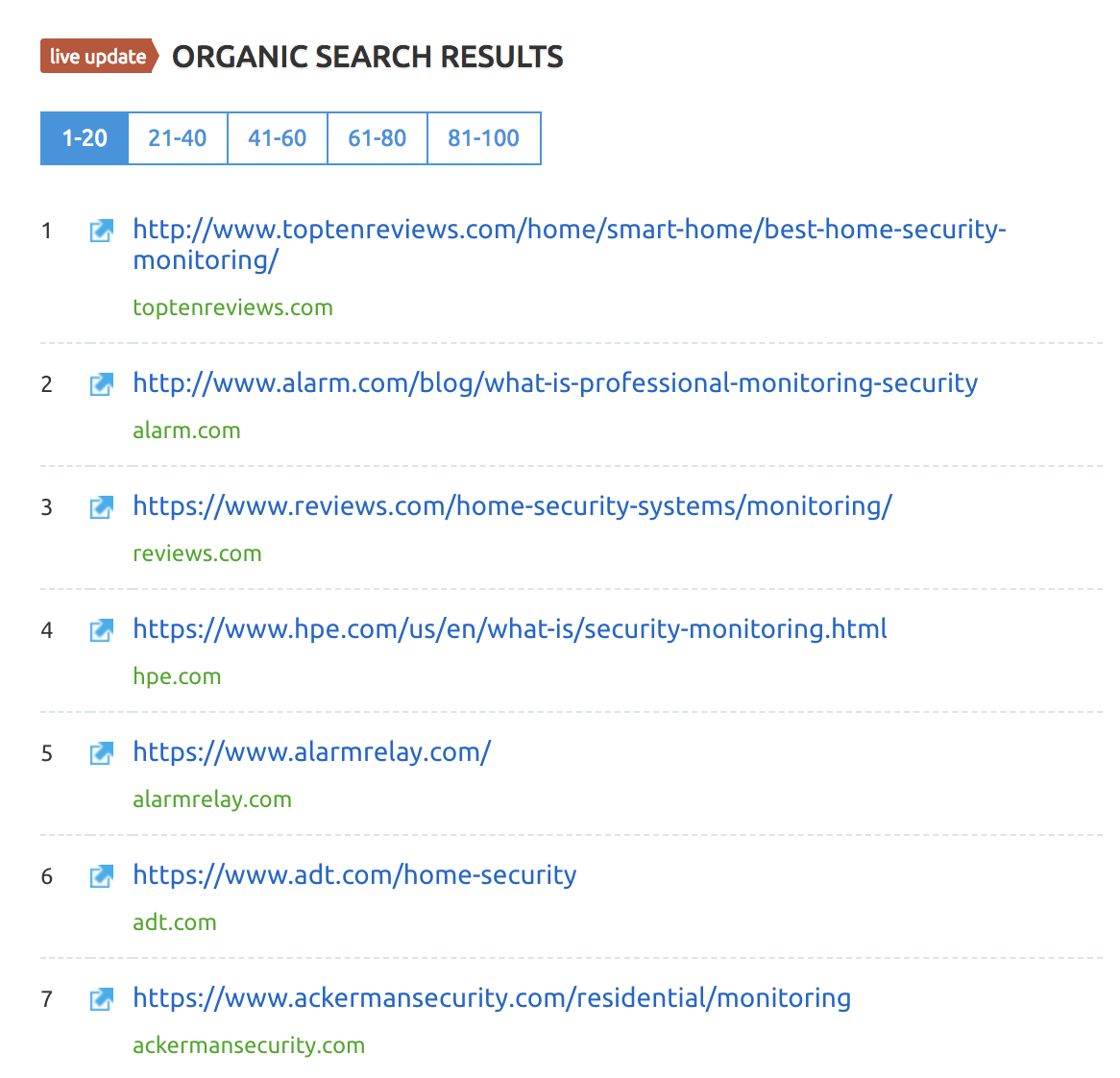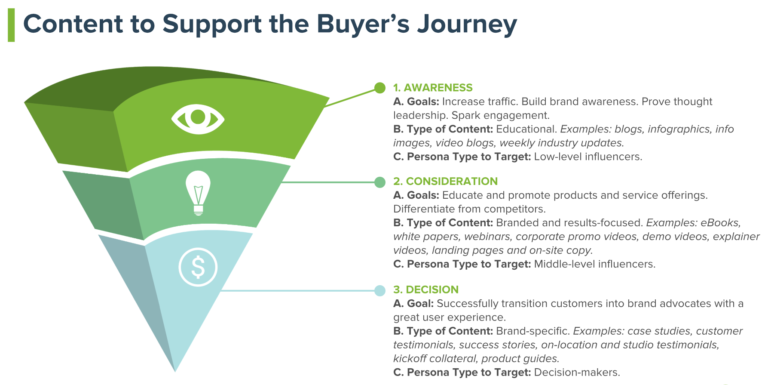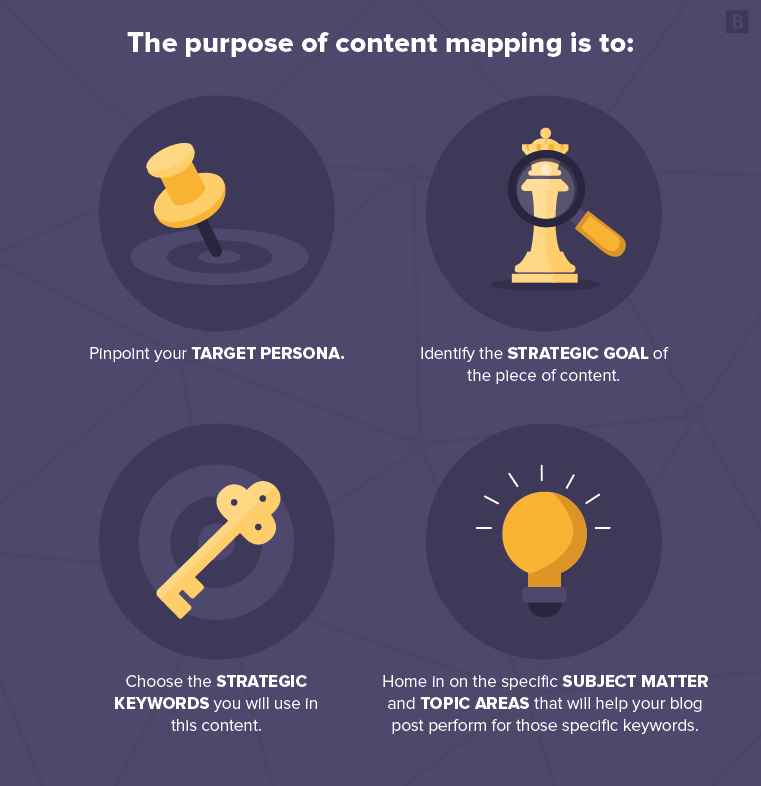What is a blog strategy and why is it so important that you have one?
It’s a simple question with a simple answer: Your blog posts are how you satisfy searcher intent for your target audience. We’ve said it before, and we’ll say it again. Web users very rarely search for brands; they search for answers.
Your company’s job is to anticipate the types of questions your potential leads are asking and to answer those questions on your blog to satisfy searcher intent. This should be the No. 1 objective of your blog strategy (and your inbound marketing strategy in general) – but not the only objective.
Once you get your audience’s attention with your blog, you need a way to keep it, and even build it into interest in your brand. So basically, you can think of your blog’s objective at a very high level:
- Create first contact with a potential lead by developing content that they will find relevant to their search intent.
- Embed some sort of mechanism into that first contact (e.g., email capture and/or retargeting in exchange for exclusive content) that significantly improves the probability of second contact.

Ok, so how do I create a blog strategy?
It’s easy enough to wrap your mind around the why of a blog strategy, but the how is a different story. Execution needs to be incredibly precise.
First and foremost: Know your audience
You need to understand your audience to anticipate the types of questions they’re asking. We cannot stress this enough. Your entire blog strategy is dead on arrival if you get this part wrong. Everything, from your keyword selection to your writing style to content length to how you promote your content and beyond are ultimately determined by who you’re talking to.
Our recommendation? If you’re just starting out with a new blog, create formal buyer personas. Give them names, ages, jobs, career goals and interests.
If you have an existing blog, create reader personas. These are more or less the same as buyer personas, but they focus more on the types of people who actually consume your content, not just on your buyers. (More on this, here.)
Also, involve your sales people in this process. They have a lot of experience chasing down cold and warm leads alike. Sure, content marketing is indeed in the domain of marketing. But your sales team’s insights can help bring your target audience into focus.
On the whole, think of persona development in this way: The buyer’s journey is like the hero’s journey. Imagine trying to develop a storyline for “Star Wars” or “Harry Potter” without first figuring out who Luke Skywalker or Harry Potter is. The plot moves forward based on the decisions these characters make. Likewise, the buyer’s journey progresses based on decisions that your target audience makes. You need to guide those decisions in your brand’s favor by understanding their intentions and knowing how to influence them.
Be the Yoda that your Luke Skywalkers need.
Incorporate SEO into your blog strategy
Search engine optimization and blogging go hand-in-hand for several reasons:
- More opportunities to satisfy searcher intent: Each new blog post is a newly indexed web page for Google and other search engines to crawl as they attempt to match a search query with existing web content. If the content on those pages satisfies queries, you can drive additional traffic to your website.
- Backlink opportunities: Your domain authority has the potential to increase every time a credible website links back to your content. These “good” links tell search engines that your website is a trustworthy source of good information about a certain topic. What’s a great way to increase backlinks? By creating useful, informative and interesting content that other sites and influencers will link back to.
Both are crucial for creating informative, searcher intent-driven content that will perform well on Google.
As for how to achieve those outcomes?
We’ll start with keywords, which are the terms that your target audience might type into a search bar as they look for answers or information. When developing a blog strategy, it’s important to create a list of keywords that will guide your content creation efforts.
In the research process, you first want to make sure you know the persona you’re trying to reach and the specific keywords you need to rank for in order to achieve that goal. Next, you want to look for something that has an ideal mix of search volume, organic keyword difficulty and SERP crowding.
For example, let’s say you provide a broad suite of cybersecurity products, and you’re targeting IT operations teams that want to improve their ability to monitor potential security threats on their network.
At first glance, “security monitoring” looks like a promising keyword.

2,400 isn’t bad as far as monthly search volume goes. The percentage on the right, (72.97) is an indicator of the keyword difficulty. The closer that number gets to 100, the harder it is to rank for. By SEMRush standards (different tools use different scales), 50 is ideal for a site that has existed for a little while and already has some traffic. Sites that are just starting out will need something much lower (in the 30 range by SEMRush standards). Anything above 80 will require a very comprehensive SEO effort.
Then you have to ask the question: What are these 2,400 monthly searchers actually looking for when they use the term “security monitoring” in their queries? Remember, we’re talking about a specific type of security here – cybersecurity, and more specifically, monitoring threats on a network. To find out if “security monitoring” term aligns with that searcher intent, perform further research to identify the pages that rank well for your keyword. Here’s what you’ll come up with:

Most of these are pertinent to home alarm systems, not information security. Clearly, then, “security monitoring” is not the keyword you are looking for.
Do this process again and again until you’ve created a list of keywords that clearly point to subjects and topics you know your personas are searching for.
Keywords matter. But remember that Google is smart and getting smarter. In fact, it has algorithms (like Panda) that are designed specifically to sniff out instances of keyword stuffing in content.
That’s not all. We talk about Google’s Hummingbird algorithm a lot on this blog, and for good reason. Rather than focusing exclusively on the meaning of individual keywords, Hummingbird parses natural language in an attempt to contextualize the meaning of the search query as a whole. In other words, loading your copy up with keywords won’t do anything if you fail to satisfy the searcher intent associated with those keywords. This is important to keep in mind as you move into the next phase of your blog strategy: writing.
Create content with purpose
So you have your personas that your blog is targeting and a starting list of keywords that you want to rank for. Now you can start the ideation process.
Ideation’s role in your blog strategy is to create persona- and keyword-driven blog topic ideas that align with your strategic objectives.
When we say “strategic objectives” we generally mean the two aforementioned purposes of your business blog (first contact, and a mechanism to facilitate second contact).
However, each blog post may have a different strategy for achieving these ends.
For example, if you have deeper-funnel collateral such as a white paper or eBook, you might use a blog post as a type of lead magnet. Specifically, you incorporate keywords and semantic keywords (more on semantic keywords in just a minute) into a blog post that teases the deeper-funnel asset.
The purpose is to make that first point of contact, your blog post, easier to find for your target personas. Once discovered, your blog post’s job is to increase the likelihood that a visitor will exchange their contact information for your gated collateral.

As for the nuts and bolts of blog topic ideation? We recommend developing a formal content mapping strategy.
The purpose of content mapping is to:
- Pinpoint your target persona.
- Identify the strategic goal of the piece of content.
- Choose the related topics you will discuss in this content.
- Home in on the specific subject matter and topic areas that will help your blog post support the target keyword.
For No. 4 on this list, you’ll need to address topics that are contextually relevant to your primary keyword. Remember Google Hummingbird? It can associate certain topics back to your target keyword. It understands the intent for each search query, meaning it’s your job to cover the topics associated with those keywords in adequate depth.

You also benefit from performing content depth and topic-coverage analysis. Essentially, you look at the top-performing content and web pages for your keyword to identify points to touch on in your blog content.
Word count is also a helpful indicator of content depth, since it provides an idea of how much detail a particular keyword is being covered in. More words does not automatically equal better quality content, though. A high word count means you have to say a lot more with your additional words, not that you need more words to say the same thing.
Once you have all the information you need to start writing, block off a few hours to sit down and focus on content creation and only content creation.
As you’re writing, look out for opportunities to incorporate imagery to break up the copy and make the content more engaging. Try to speak the language of your target persona, and make sure that the information you include is accurate. If you’re going to use statistics from a study, cite that study, and make sure it’s credible.
Before publishing, we recommend checking out The Blog Starter tips on making your first blog post in WordPress. Then get a second and a third pair of eyes on your content to make sure that it doesn’t suck. Preferably, make sure at least one of them knows a thing or two about good writing and proper grammar.
*A note about publishing guest posts on your blog
Not everything referenced above will always apply to guest posts. Yes, you absolutely want to edit that post for readability, accuracy, proper citations and so on. You also want to check for plagiarism, because that’s really bad for SEO and your brand’s credibility. Generally speaking, though, the main benefit of guest posts are:
- Influencer marketing: If your guest blogger is a CEO of a successful company, an industry analyst or some other type of influencer, there’s a good chance he or she will attract additional web traffic. That’s good for your brand and your blog.
- Backlink opportunities: If you increase the number of eyes on that content, you increase backlink opportunities. Think about it this way: The same people who would normally link back to your guest blogger’s content may not link back to your blog.
This is to say, don’t hold your guest bloggers accountable for all the steps you would demand of your marketing team. They play a strategic role for improving blog traffic in and of themselves.
Publishing and promoting your masterpieces
So you’ve done all the hard work: the strategic planning, the keyword research, the content mapping, and so on and so forth. At long last, it’s time to publish. This process may require some coordination with your development team in order to smooth out integrations and any backend issues. But in general, publication is really in the hands of the marketing team.
Still, consider coordinating with sales when creating a posting schedule. They’re sometimes privy to upcoming conferences, promotions or other important events that can have a strategic benefit for your blog. And in general, sales and marketing alignment is a good thing.
The more often you post on your blog, the better – presuming of course, you actually have the high-quality content to post. Obviously you’ll only have finite amount of resources to put toward your blog strategy. If you have have to choose between quality and quantity, always go with quality. One great post a week will do a lot more for you than five bad or mediocre posts.
And finally, once your post is live, it’s time to promote it. Start with the most profitable content marketing channel, email. Create simple but compelling subject lines that will drive up open rates, and hopefully improve blog traffic.
Next, share your content on your social media channels – Facebook, Twitter, LinkedIn, Instagram and so on. Your blog content and your social media presence are in a symbiotic relationship. Your blog gives your social channels something for followers to chew on. Your social media channels promote your blog.
Rinse and Repeat
Once you have the basic framework down for a blog strategy, just keep retooling as needed to keep getting the best result possible.
Also pay attention to your own internal processes. Use project management tools and shared spreadsheets to manage deadlines and schedules. Put someone in charge of performing your keyword analysis, and maybe task someone else with the execution and writing. A third person might handle your promotions. And if it becomes too much, don’t hesitate to look for help from a content marketing agency.
Otherwise, just keep on keeping on. Blogging is a long game. You gradually improve your web presence, build lead lists by including email signups in your content (whether through a scroll-triggered box or through gated content) and generate traffic to your site.
Rome wasn’t built in a day, and neither is your blog. But after a whole lot of trial and error, the great city still stands – and so will your blog if you give it the upkeep and care that make a good enough thing, great.





